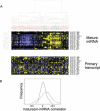Extensive post-transcriptional regulation of microRNAs and its implications for cancer
- PMID: 16882971
- PMCID: PMC1553203
- DOI: 10.1101/gad.1444406
Extensive post-transcriptional regulation of microRNAs and its implications for cancer
Abstract
MicroRNAs (miRNAs) are short, noncoding RNAs that post-transcriptionally regulate gene expression. While hundreds of mammalian miRNA genes have been identified, little is known about the pathways that regulate the production of active miRNA species. Here we show that a large fraction of miRNA genes are regulated post-transcriptionally. During early mouse development, many miRNA primary transcripts, including the Let-7 family, are present at high levels but are not processed by the enzyme Drosha. An analysis of gene expression in primary tumors indicates that the widespread down-regulation of miRNAs observed in cancer is due to a failure at the Drosha processing step. These data uncover a novel regulatory step in miRNA function and provide a mechanism for miRNA down-regulation in cancer.
Figures




References
Publication types
MeSH terms
Substances
LinkOut - more resources
Full Text Sources
Other Literature Sources
Molecular Biology Databases
